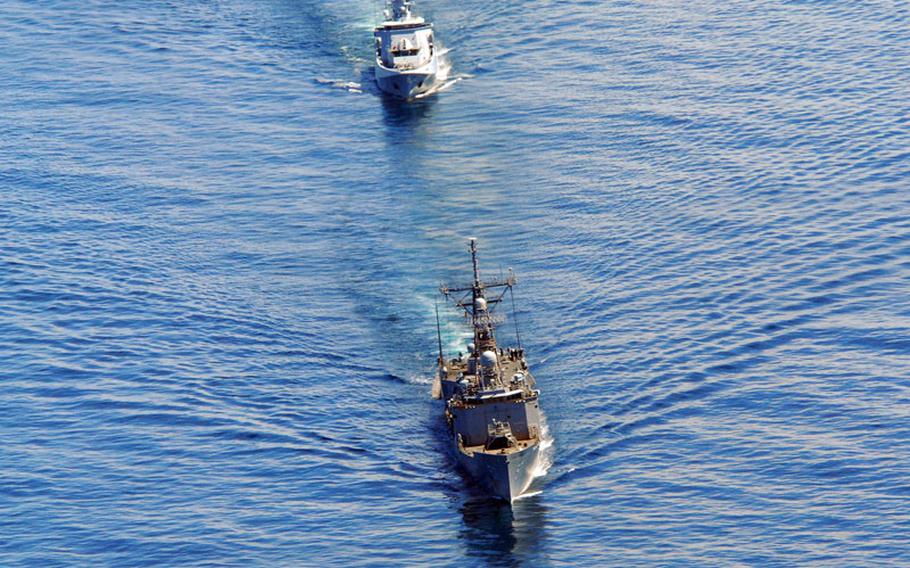
The guided missile frigate USS Reuben James, foreground, and the Royal Brunei Navy offshore patrol vessel Darulehsan sail in formation during Cooperation Afloat Readiness and Training (CARAT) 2012 in November 2012, in the South China Sea. (Ryan Meador/U.S. Navy via DVIDS)
YOKOSUKA NAVAL BASE, Japan — A Chinese amphibious task force conducted patrol and training missions at a shoal 50 miles from Malaysia’s coast Monday, furthering its assertive claims to nearly all territory in an area that most of the world considers international waters.
Chinese officials said they “were determined to safeguard the country’s sovereignty with their services on the South China Sea” during a ceremony at uninhabited James Shoal, according to Xinhua news agency and the People’s Daily Online, the Communist Party’s official newspaper.
China often sends fishing boats and quasi-military surveillance ships to the hundreds of islands and reefs in the South China Sea that are also claimed by neighboring countries. The visit to James Shoal, known as Zengmu Reef to China, was unusual for the firepower brought to bear on a territory also claimed by Malaysia and Taiwan.
The task force was led by the landing ship Jinggangshan, a 19,000-ton displacement, nearly 700-foot vessel considered by China military analysts to be among the more advanced of the country’s rapidly modernizing military. The craft is able to transport helicopters, marines and air-cushion landing crafts, according to analysts.
Official Chinese outlets said the show of force reasserted China’s claim to what it considers its southernmost territory.
Independent outlets in the region viewed the exercise as a possible glimpse into maritime policy under new leader Xi Jinping, who is thought to have close ties to China’s military leadership.
“We’ve never seen anything like this that far south in terms of quantity or quality,” Gary Li, a senior analyst with IHS Fairplay in London, told the South China Morning Post. “It is hard to know whether it is just coincidence, but it does seem to reflect [President] Xi Jinping’s desire for more practical operationally based exercises.”
The submerged shoal’s actual value is more symbolic than strategic. Bill Hayton, who is writing a book on the South China Sea, reported in February that China has repeatedly reinforced its claim by heaving an engraved stone over the side of a ship at the shoal.
U.S. 7th Fleet officials declined comment Tuesday on the Chinese operation at James Shoal. U.S. Navy ships and aircraft based in Japan have regularly patrolled the south and east China seas in recent years, as disputes between nations in the region have intensified.
In the past two years, the U.S. Navy has forged closer military ties with the Philippines and Vietnam, each of which has had multiple standoffs with Chinese ships over islands. Earlier this month, Vietnamese officials accused a Chinese ship of firing on a Vietnamese fishing vessel transiting the disputed Paracel Islands.
China claims nearly all land within its “9-dash line” map, which includes most of the South China Sea, and justifies its claim largely on what it considers historical discoveries.
It also reserves the right to regulate the sea’s generally recognized international waters, a position that clashes with that of the U.S. Navy which views its presence as a safeguard to freedom of navigation.
Twitter: @eslavin_stripes